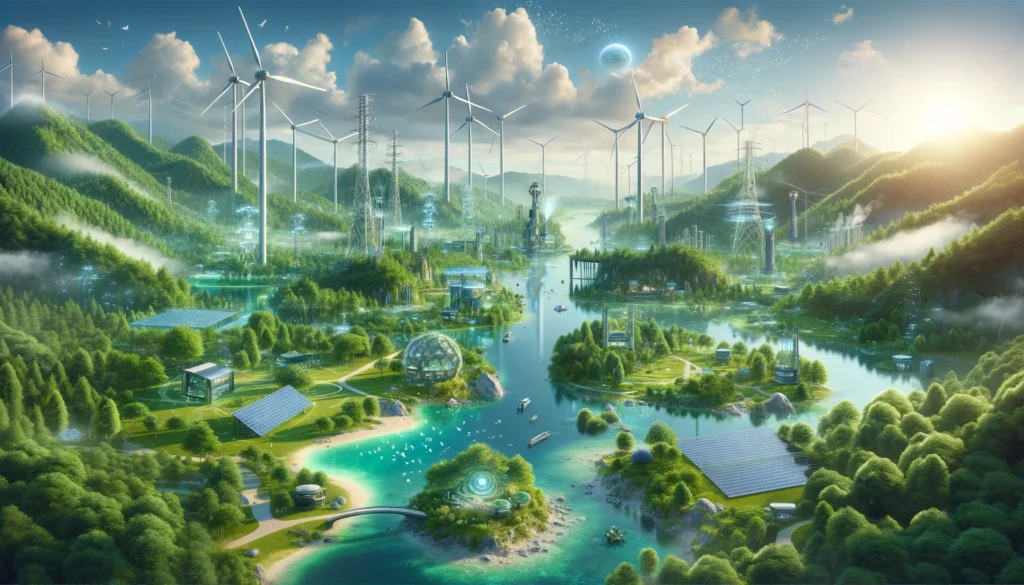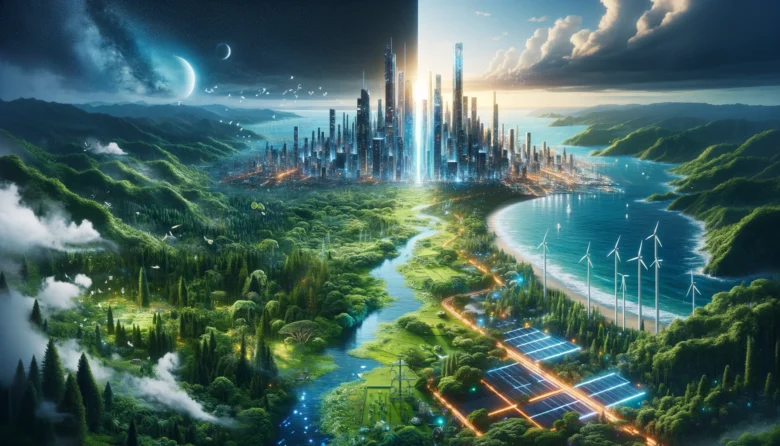In the bustling world of technology, Artificial Intelligence (AI) stands out as a beacon of innovation and progress. Yet, beneath its shiny surface lies a pressing concern—its impact on our planet. But don’t worry; this isn’t just another doom-and-gloom tale. Instead, we’re diving into a story of hope, where green algorithms emerge as heroes in the quest for a sustainable future. Let’s embark on a journey to explore the challenges and triumphs of AI in its relationship with environmental sustainability.
The Dual Faces of AI: A Tale of Energy and Waste
Imagine AI as a voracious energy eater, devouring vast amounts of electricity for its operations. Training a single AI model can emit as much carbon as five cars do in their lifetimes! Here lies our first challenge: managing this appetite without letting emissions skyrocket. But the plot thickens with the issue of electronic waste. As we chase the latest in AI tech, we also pile up a mountain of e-waste, a silent villain in our environmental story.
Yet, in every tale, there’s a twist. AI systems, if not carefully designed, can mimic the biases of their creators, leading to a world where inequality thrives, even affecting our environmental efforts. And as we weave our lives more tightly around these digital companions, we risk losing touch with the natural world, becoming actors in a play where technology holds the strings.
 Innovations in Green Computing: The Rise of the Eco-Friendly Machines
Innovations in Green Computing: The Rise of the Eco-Friendly Machines
Fear not, for this story also has its knights in shining armor. Innovators across the globe are reimagining AI hardware to sip, not gulp, power, making these machines both mighty and eco-friendly. Imagine processors so efficient that they drastically reduce the energy needed for AI’s tasks.
Companies like Google, Apple, and Facebook are turning to renewable energy to power their digital fortresses, slashing carbon footprints and setting the stage for a greener future. These efforts shine as beacons of hope, proving that technology and sustainability can indeed walk hand in hand.
AI for Environmental Good: Heroes in Digital Disguise
Now, let’s turn the page to AI’s role as an environmental guardian. From optimizing energy use in skyscrapers to making electric cars smarter, AI is on a mission to cut waste and boost efficiency. It’s not just about saving energy; it’s about reshaping how we use our resources, guiding us towards a more sustainable existence.
In the realm of renewables, AI acts as a mastermind, predicting and adjusting to the whims of nature, ensuring that wind and solar power reach their full potential. And as for agriculture, imagine robots that can tell a weed from a plant and weed it out, reducing the need for harmful chemicals and fostering a healthier Earth.
From Tales to Reality: Case Studies of Green Algorithms in Action
Let’s dive deeper into the fascinating world of case studies where AI has already made strides towards sustainability, while also addressing its significant carbon footprint and environmental impacts. This exploration isn’t just about showcasing success stories; it’s about understanding the journey towards a more sustainable AI, acknowledging the challenges, and recognizing the innovative solutions that pave the way forward.
DeepMind’s Energy Efficiency Leap
DeepMind, an AI research lab, made headlines when it tackled the energy consumption of Google’s data centers. By optimizing cooling systems using AI algorithms, DeepMind managed to reduce energy usage by a staggering 40%. This breakthrough illustrates AI’s potential to significantly cut carbon emissions in one of the most energy-intensive areas of the ICT (Information and Communication Technology) industry. It’s a shining example of how AI can turn the tables on its own carbon footprint, transforming from a power-hungry giant into a guardian of sustainability.
 GE Renewable Energy’s Smart Wind Turbines
GE Renewable Energy’s Smart Wind Turbines
Imagine wind turbines that can predict the weather and adjust themselves to capture every breath of wind. GE Renewable Energy (an American company) has turbines, equipped with AI and sensors, that do exactly that. By analyzing data in real time, these turbines optimize their performance, leading to more efficient energy production and a considerable reduction in carbon emissions. This case not only highlights AI’s role in enhancing renewable energy sources but also showcases its ability to coexist with nature by harnessing its forces more effectively.
Waste Robotics: AI-Powered Recycling
In the battle against e-waste, AI emerges as a key player. Waste Robotics has deployed AI-driven robots to sort and separate recyclable materials, improving the efficiency of recycling processes. This technology not only reduces the amount of waste that ends up in landfills but also ensures that hazardous materials from electronic waste are properly managed. By tackling the e-waste challenge, AI demonstrates its capacity to address its own environmental drawbacks, promoting a circular economy where resources are reused and recycled.
Addressing AI’s Carbon Footprint and Environmental Challenges
Despite these promising developments, the environmental toll of AI’s carbon footprint and its broader impacts cannot be overlooked. The massive energy consumption required for training and running AI models has significant repercussions for greenhouse gas emissions, contributing to climate change. The stark comparison of training a large AI model to the carbon emissions of hundreds of flights underscores the urgent need for greener algorithms and more sustainable practices in AI development.

Moreover, the proliferation of AI technologies has led to increased electronic waste, posing severe risks to both human health and the environment. The anticipated surge in e-waste necessitates a robust approach to recycling and waste management, emphasizing the need for AI systems designed with sustainability in mind from the outset.
The impact of AI on natural ecosystems, through applications such as autonomous vehicles and intensive agricultural practices, further complicates the relationship between AI and the environment. These challenges highlight the importance of ethical considerations and the need for AI systems that prioritize long-term environmental sustainability over short-term gains.
To navigate these complexities, a multifaceted approach is essential. Investing in research for energy-efficient AI hardware and algorithms, adopting transparent and responsible AI practices, and fostering collaboration across sectors can pave the way for a sustainable AI future. By addressing these challenges head-on, we can ensure that AI serves as a force for environmental stewardship, balancing its growth with the health of our planet.
Towards a Sustainable AI Future
As we reflect on these case studies and the broader environmental challenges posed by AI, it’s clear that the path to sustainable AI is both challenging and rewarding. By embracing innovation, accountability, and a commitment to sustainability, we can steer AI towards a future where technology and the environment thrive together. The journey of AI from a contributor to environmental challenges to a key player in sustainability efforts underscores the transformative power of technology when guided by a vision for a greener, more sustainable world.
In this ongoing narrative, every effort towards sustainable AI practices is a step forward in our collective quest for a balanced and sustainable future. As we continue to explore and innovate, the potential for AI to drive positive environmental change is limitless, offering hope and inspiration for the road ahead.
Conclusion: A World of Possibilities
As we close this chapter, remember that the narrative of AI and environmental sustainability is still being written. It’s a story of challenges and opportunities, of risks and rewards. By engaging with this tale, we become part of a global community committed to ensuring that as AI marches forward, it does so hand in hand with our planet’s well-being.

So, let’s keep the dialogue open, stay curious, and play our part in this ongoing story. The future of AI is not just about technological breakthroughs; it’s about crafting a legacy of sustainability, innovation, and shared prosperity. Join us in this journey towards a greener, more sustainable world, where green algorithms light the way to a brighter future.
Author’s Note:
As we stand at the crossroads of innovation and environmental stewardship, it’s essential to recognize AI’s dual role: as both a challenge and a solution to sustainability. Through the stories of DeepMind, GE Renewable Energy, and Waste Robotics, we glimpse the potential for a harmonious future where technology uplifts rather than undermines our planet’s health.
This exploration is more than an account of advancements; it’s a call to action for mindful development and utilization of AI. As we navigate the complexities of our digital and natural worlds, let’s commit to fostering technologies that honor and protect the delicate balance of our environment.
G.C., Ecosociosphere contributor.
References:
- “The Green Dilemma: Can AI Fulfil Its Potential Without Harming the Environment?” on Earth.Org provides an in-depth look at AI’s environmental footprint and sustainable AI practices. Read more.
- “8 Ways AI Can Contribute to Environmental Conservation” on 2030.builders outlines specific strategies through which AI aids in sustainability efforts across different sectors. Explore further.





Comments
Your point of view caught my eye and was very interesting. Thanks. I have a question for you.
I don’t think the title of your article matches the content lol. Just kidding, mainly because I had some doubts after reading the article.
Your point of view caught my eye and was very interesting. Thanks. I have a question for you.